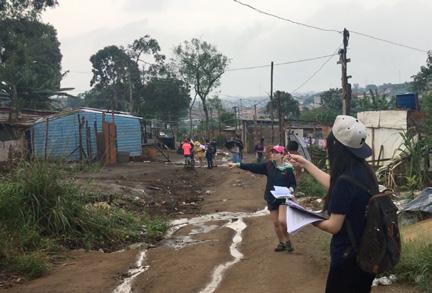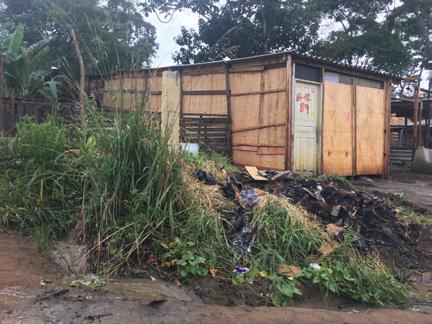
3 minute read
Water and Stormwater
DIRECT OBSERVATION
Direct observation surveys helped identify current, observable conditions at the Ocupação Anchieta site. Points of interest included litter, sewerage, topography, stormwater and greywater runoff, construction materials and styles, as well as evidence of electricity and other technology. Surveyors supplemented these checklists with written field notes and geo-located phone pic-tures. These surveys were informed by UN Habitat, the World Health Organization, and the 2015 Santa Marta Capstone, also under direction of Professor Ana Paula Pimentel Walker.
53 (left) Taubman Team Walks Through Occupation Towards Instituto Anchieta Grajaú.
The direct observation method allowed Taubman Team students to gather data on housing typologies and materials, prevalence of solid waste and pollution, and types of infrastructure related to sewage, water, and electricity. Students collected data at the parcel level. Although residents had informally delineated lots at the time of occupation, they have never been formalized. Students observed conditions of the housing structures and the lots surrounding it.
The direct observation checklist included only measures of physical conditions. Housing and infrastructure indicators from the UN-HABITAT Program and WHO inspired checklist items (UN Habitat, 2004 and WHO, 2017). Students gathered data by filling out a series of checklists approximately every two housing structures near the creek and every six housing structures in the rest of the Occupation. The reason for concentrating direct observation around the creek comes from the importance of protecting this water feature, especially as it relates to tenure security. Over the course of the three-day site visit, 110 direct observation checklists were completed. Although we did not observe every house, the direct observation method ensured that most streets within Ocupação Anchieta were covered. Question 17 is open-ended and has been excluded in the analysis.
WATER AND STORMWATER
The checklists included six questions that addressed the proximity of housing to the creek and stormwater runoff (1 and 8-12). Out of the 110 direct observation checklists collected, the Taubman Team found that the overwhelming majority of houses (91%) have already been relocated out of the creek and springs vegetative area, and only a few foundations remain (Question 1). One-hundred and forty houses surrounded the creek until an NGO,
54 Students Conduct Direct Observation.
55 Housing Assessment. called TETO, relocated houses adjacent to the creek from November 2016 and January 2017. Additionally, students looked for areas where flooding may occur (Question 11). It rained the first day on site, which helped the Taubman Team better identify flooding risk and the direction of stormwater runoff. Ninetyfive percent of checklists reported no flooding risk. Slightly less than half (42%) of checklists recorded stormwater as leaving the site and a little over half (58%) reported that stormwater remains within the Occupation. This finding suggests that the creek and surrounding vegetation plays a role in stormwater retention and infiltration.

Upon arrival, the Taubman Team discovered that the stormwater information applied to the entire site. Thus, students decided to no longer collect data on questions 8, 9, 10 and 12 after the first day since these questions pertained to the stormwater. Approximately 75% of the Occupation has a rudimentary above-ground stormwater system, including precarious pvc piping and water-carved ditches along this sides of the dirt roads. The Taubman College Team did not use descriptive statistics for analyzing stormwater because questions could be observed for the Occupation as a whole. However, there is no one stormwater infrastructure situation that applies to the entire site. Just as the stormwater systems are informal, so are the ways in which wastewater is managed. Much of the wastewater flowed either into above ground systems or directly into the creek. The evident lack of infrastructure suggests that residents contribute to the pollution of the creek and the surrounding environment.






